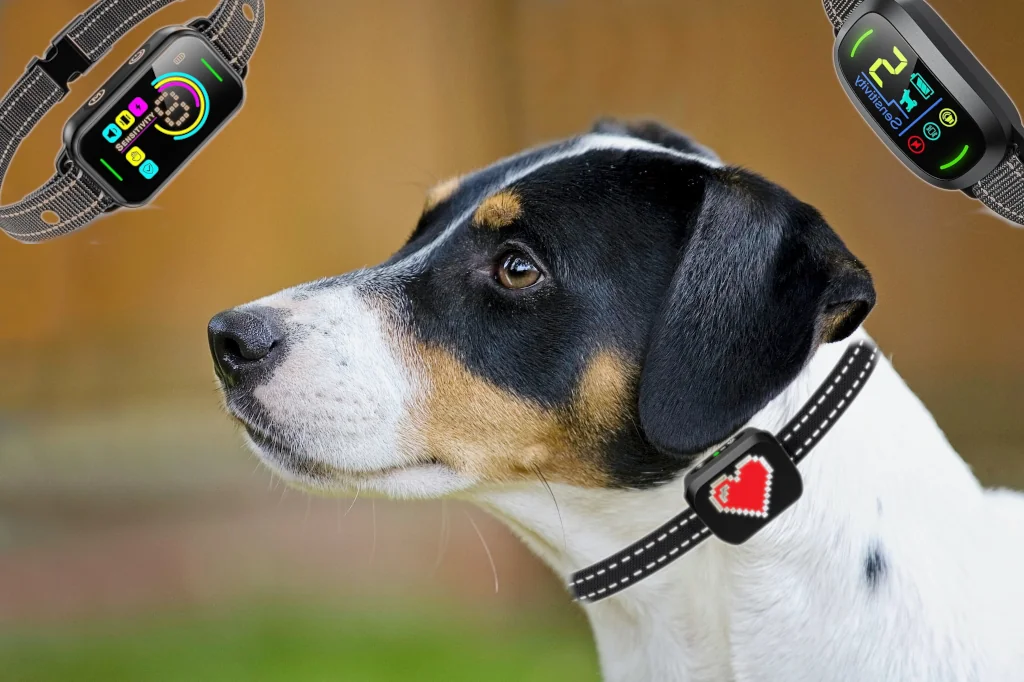Disclosure: We may earn a commission from helpful, relevant links in our content. No cost to you. See our privacy policy.
Your dog’s constant barking has you at your wits’ end.
You’ve tried everything but the chorus of canine cacophony remains unabated. It disrupts your peaceful evenings and the neighbors are starting to complain.
Enter anti-bark collars and devices, a possible solution that’s generated quite a buzz in the dog training world. So, with all the noise – no pun intended – can they provide the much-needed quiet?
Let’s explore the ins, outs, and all about these devices and whether they’re the right choice for your pooch. We’ll give you the essentials on these devices, whether they work, provide a few recommendations, as well as give you alternatives to these devices. Let’s get to it.

Do Anti-Bark Collars and Devices Work?
Anti-bark collars and devices do indeed work…sort of.
They can effectively silence your dog’s bark but it’s crucial to note that they aren’t a magic wand that waves the problem away.
These devices function through creating a deterrent – a sensation unpleasant enough for your dog to want to avoid, hence curtailing the barking. This might be a citronella spray, ultrasonic sound, or even a static shock.
However, while they may provide a temporary reprieve from the barking, they are not the most ethical nor the most permanent solution. Their mechanism does not address the root cause of excessive barking and could potentially lead to further behavioral problems. Moreover, once removed, your dog might simply revert to its previous barking habits.
We at AnimalReport advocate for positive reinforcement as the first port of call in managing your dog’s behavior. It’s a more humane, long-lasting approach to curbing excessive barking. For those committed to this path, check out our blog post on understanding and managing barking for in-depth guidance.
Nonetheless, we recognize that some dog owners may opt for anti-bark devices and it’s important that they make an informed choice. So let’s dive into what these devices offer, their pros, and their potential downsides.
What Kind of Anti-Barking Devices Are Available?
Anti-barking devices come in all shapes and sizes, each designed to combat excessive barking in a different way. Here, we’ll outline the major types and provide some top recommendations for each.
Ultrasonic Devices
Ultrasonic anti-bark devices emit a high-frequency sound that only dogs can hear. It’s an annoying noise that interrupts and deters barking. The devices are often contained within a collar but can also be standalone units.
They’re generally not harmful but should be used with caution around sensitive dogs, as the noise, while inaudible to us, can be distressing for them. That said, these devices can be particularly useful for dogs that are responsive to auditory stimuli. If your dog tends to respond to noises or is a reactive barker (barking at sounds), an ultrasonic device might be a good choice.
Recommended Option: NPS 2023release Dog Bark Deterrent Device – is a versatile and effective training tool. It has diverse modes, hearing protection auto-shutoff, and high-praise customer reviews that affirm its efficacy, making it a standout choice.
Citronella Spray Collars
These collars release a burst of citronella spray when your dog barks. Dogs generally find the scent unpleasant and, over time, learn to associate barking with this unfavorable experience.
The biggest advantage is that they’re usually more humane than shock collars. However, some dogs might become habituated to the scent over time and start to ignore it. Furthermore, if your dog is sensitive to smells or has allergies, a citronella collar might not be the best choice.
These are best suited for dogs who are not particularly stubborn and are likely to be deterred by the unpleasant scent.
Recommended Option: Petsafe Gentle Spray Anti-Bark Collar – it’s lightweight, water-resistant, and adjustable for comfort. Plus, the citronella spray is stain-free.
Vibration Collars
Vibration anti-barking collars work by sending a vibrating pulse to interrupt your dog’s barking. They are considered one of the more humane options as they don’t rely on shock or unpleasant scents.
This type of collar is less likely to cause stress or fear compared to other types. However, some dogs may get used to the vibration over time and ignore it. These work best for sensitive dogs who are likely to respond to the surprising sensation of the collar.
Recommended Option: DogRook Rechargeable Dog Bark Collar – it features 7 adjustable sensitivity levels and two training modes – vibration and beeps.
Static Shock Collars
These collars deliver a mild electric shock when your dog barks. It’s important to note that, while these can be effective, they are also the most controversial due to concerns about animal welfare.
While the shock delivered is generally mild, it can still cause stress or fear. For these reasons, shock collars should be used as a last resort and always under professional guidance. If your dog is highly resistant to other methods and the barking is causing significant issues, you may consider a shock collar – but always with the guidance of a professional trainer.
Recommended Option: SportDOG Brand NoBark Rechargeable Collars – it offers 10 levels of static stimulation and three programmable modes to customize to your dog’s needs.
Here’s a summary table of each of these anti-bark device types, how they work, with a recommended option for each one:
| Type of Device | How It Works | Recommended Option |
|---|---|---|
| Ultrasonic Devices | Emit a high-frequency sound to interrupt barking | NPS 2023release Dog Bark Deterrent Device |
| Citronella Spray Collars | Release a burst of citronella spray to create an unfavorable experience | Petsafe Gentle Spray Anti-Bark Collar |
| Vibration Collars | Send a vibrating pulse to interrupt barking | DogRook Rechargeable Dog Bark Collar |
| Static Shock Collars | Deliver a mild electric shock when dog barks | SportDOG Brand NoBark Rechargeable Collar |
Each of these devices has its pros and cons and what works best will depend on your dog’s individual personality and circumstances. Remember, these devices should never replace a comprehensive training program that addresses the root cause of the excessive barking.

What to Consider When Choosing an Anti-Barking Device?
Selecting an anti-barking device requires careful consideration. It’s not just about stopping the noise, but ensuring your dog’s well-being is not compromised. Here are a few key factors to keep in mind:
- Your Dog’s Size and Age. Different devices suit different sizes and ages. A vibration collar, for instance, may not be effective on a large, robust breed. Conversely, a high-intensity ultrasonic device might be too harsh for a puppy.
- The Reason for Excessive Barking. Is your dog anxious, bored, or reacting to certain triggers? Understanding the root cause can help you select a device that addresses the specific issue more effectively.
- Ease of Use and Maintenance. Choose a device that’s easy for both you and your dog to get used to. Additionally, consider factors like battery life, waterproofing, and ease of cleaning.
- The Environment. If you live in a close-knit neighborhood, an outdoor ultrasonic device could potentially affect other dogs in the vicinity.
Bonus Tip: Check for Adjustable Sensitivity – An often overlooked feature, adjustable sensitivity, allows you to fine-tune the device according to your dog’s specific barking patterns, ensuring it isn’t triggered by other noises.
Are There Downsides to Using Anti-Barking Devices?
Anti-barking devices can certainly be effective, but they’re not without their potential pitfalls:
Dependence
Some dogs may become dependent on these devices, reverting to barking once the device is removed. They can be a good temporary solution, but long-term, it’s important to address the underlying cause. Our guide on barking can help you with that.
Fear and Anxiety
Devices that use shocks or harsh noises can cause fear and anxiety in dogs. Consider these carefully and prioritize gentler methods whenever possible.
Ineffectiveness
Sometimes, the device might simply not work for your dog. Each dog is unique and what works for one may not work for another.
Possible Health Implications
Devices that use static shock or strong scents could potentially have health implications for some dogs, including skin irritation or allergic reactions.
In essence, while these devices can be part of the solution, they’re not a one-size-fits-all answer to excessive barking. A comprehensive training plan that addresses the root cause of the behavior is always the best approach.
Any Other Methods to Reduce My Dog’s Barking?
Certainly, there are a myriad of ways to manage your dog’s barking beyond devices. Here are a few methods that are rooted in empathy and understanding of canine behavior:
- Understand the Cause. First, identify why your dog is barking a lot. It might be due to anxiety, boredom, or a response to certain triggers. Once you understand the root cause, you can tailor your approach more effectively.
- Provide Mental Stimulation. Often, dogs bark out of boredom. Providing them with mentally stimulating toys or challenges can distract them from unnecessary barking.
- Train and Socialize Your Pup. Regular training sessions using positive reinforcement methods can work wonders. Additionally, socializing your dog with other dogs and humans can help alleviate anxiety-based barking.
- Professional Help. If you’re feeling overwhelmed, consider enlisting a professional dog trainer or behaviorist. Their expertise can provide invaluable insight and guidance.
Pro-tip from my Experience: Teach the “Quiet” Command – This is a method that requires some patience, but it’s immensely rewarding. Start by allowing your dog to bark naturally. Then, use a soft but firm command like ‘quiet.’ Once they stop barking, reward them with a treat. Over time, they’ll associate the ‘quiet’ command with being calm and silent.
One evening, after a long day, I found Charlie, my previously untrained dog, barking relentlessly at the door. Confused, I checked and found a lost kitten huddled on my porch. That day, I understood that sometimes, Charlie’s barking wasn’t just noise, but an alert to something he deemed important.
Barking can indeed be a form of communication. Anti-barking devices can help manage excessive barking, but remember, they don’t replace understanding and patience. With time, you’ll learn to understand your furry friend’s unique language, and I promise, that understanding is worth every bark.
Thank you for being with us on this journey of understanding our canine companions better. As always, feel free to reach out with any questions. Happy training!
FAQs
What is the best device to stop a dog from barking?
The best device is one that is suitable for your dog’s size, age, and temperament. It also depends on the root cause of the barking. Ultrasonic devices are often effective. A vibration collar could be a gentler alternative for sensitive dogs, but training is the by far the best option.
How long does it take for an anti-bark collar to work?
The time it takes for an anti-bark collar to work can vary greatly, from a few days to a few weeks. It depends on your dog’s personality and the reason for their excessive barking.
Can puppies use anti-bark devices?
Certain anti-bark devices are safe for puppies, such as vibration collars or ultrasonic devices. Consult with a vet or a professional trainer before using any anti-barking device on a puppy. Since puppies are easiest to train, consider positive reinforcement before resorting to these devices.
Do anti-bark devices hurt dogs?
While most anti-bark devices are designed to be safe, some can cause discomfort or stress, particularly shock collars. It’s crucial to select a device that suits your dog’s size and temperament, and to always use such devices alongside positive reinforcement methods.
Alex, a passionate animal lover, has experience in training and understanding animal behavior. As a proud pet parent to two dogs and three cats, he founded AnimalReport.net to share insights from animal experts and expand his knowledge of the animal kingdom.




